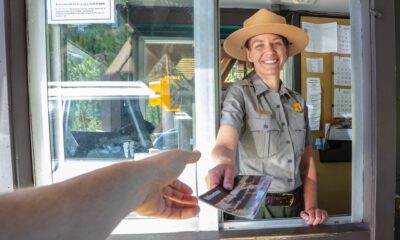Uncategorized
The New West: Jonkel and pals helped to save grizzlies by creating bear spray
Published
8 years agoon
Posted By
Outlaw PartnersSome 30 years ago, biologist-turned-college -professor Charles Jonkel, Vietnam veteran Bill Pounds, and a young researcher named Carrie Hunt never thought of themselves as being “technology disruptors.”
All they knew was that the primary status quo method used by humans to resolve grizzly encounters was resulting in a lot of dead bears, dying at rates fast pushing them to the brink of total elimination from the Lower 48.
Apart from instructing people how to react to charging bears by coiling submissively into the fetal position, hiking in larger groups, keeping clean camps, and making noise on the trail, federal and state officials involved with grizzly recovery watched the bruin death toll continue to mount
The only hope grizzlies had of persisting, Jonkel said, was finding an alternative to bullets as a mainstay for human self-defense.
A lot has been written about Jonkel since his passing last spring, notably the Canadian-American’s ferocity for championing grizzly and polar bear conservation and his founding of both the International Wildlife Film Festival in Missoula and the Great Bear Foundation, but his involvement in pioneering the development of bear spray ranks as perhaps his most enduring contribution to the cause of human-grizzly coexistence.
“Bear spray has revolutionized the way we travel in bear country, the way we think about grizzlies, and the way we’ve been able to debunk negative mythology surrounding them,” says Chuck Bartlebaugh, a bear spray crusader whose files brim with testimonials of how the bullet-disrupting technology has saved the lives of many people and bears.
“The only problem is that although bear spray is highly effective in thwarting bear attacks, it still isn’t being carried by enough people,” Bartlebaugh says. “And among those who do carry it, many aren’t knowledgeable about how to deploy it from a can.”
As Bartlebaugh and the renowned bear behavior researchers Tom Smith and Stephen Herrero told me, bear spray has demonstrated remarkable effectiveness in safely repelling bears with compelling evidence it’s far more reliable than guns in saving lives, especially at close range, which is where most maulings occur.
The profile of bear spray is about to get a major boost. Yellowstone National Park this summer, in an attempt to encourage wider use among hikers, is launching an advertising campaign called “A Bear Doesn’t Care.” It features well-known individuals who say a bruin that crosses their path doesn’t care what a person does for a living. What matters is being smart and prepared in griz country.
Yellowstone Superintendent Dan Wenk says it’s surprising, for as much as bear spray has been embraced by people in the Northern Rockies as a necessity, its adoption rate—28 percent— by park visitors overall is still considered unacceptably low.
I had many chats with Jonkel and Pounds over the years. And I admire Hunt’s work through the Wind River Institute in promoting the use of Karelian bear dogs to help agrarians protect their livestock.
Jonkel once took me to a captive facility near Missoula, Montana where wild grizzlies and black bears had been taken after getting in trouble with people or livestock and then subjected to experiments gauging their response to non-lethal repellents.
Eventually, a concoction and delivery methods were developed allowing users to quickly spray an aerosol fog of oleo-resin capsaicin (a substance also present in super-hot red peppers). Capable of reaching bears 30 feet away when shot from a can, and hanging in the air long enough for charging grizzlies to absorb it in their eyes, mouth and lungs, bear spray caused serious but temporary distress to bruins’ olfactory systems. They hated it and would retreat.
Bears, especially sows with cubs, no longer had to die for acting defensively on behalf of offspring, advancing with no intention of killing people.
Members of the Interagency Grizzly Bear Study Team whose biologists have spent years in the field swear by bear spray’s effectiveness. The research unit conducted a ten-year analysis in the 1990s which found that people who defended themselves against bears with firearms suffered injury 50 percent of the time, while those outfitted with bear spray evaded harm most of the time.
“Although no product is guaranteed to work or always 100 percent effective, I’m not aware of any case, among many I’ve reviewed, of a person dying when deploying bear spray the way it is supposed to be used,” Bartlebaugh noted.
Jonkel, Pounds (who created the product Counter Assault) and Hunt are unsung heroes, he says. “What they did was invent a game-changing innovation when it was most needed—for us and grizzlies.”
New West columnist Todd Wilkinson is author of “Grizzlies of Pilgrim Creek, An Intimate Portrait of 399, the Most Famous Bear of Greater Yellowstone” featuring photos by Thomas Mangelsen and only available at mangelsen.com/grizzly. He also wrote a feature story for the summer 2016 edition of Mountain Outlaw magazine about Yellowstone National Park Superintendent Dan Wenk. That issue of Mountain Outlaw is now on newsstands.
The Outlaw Partners is a creative marketing, media and events company based in Big Sky, Montana.


Upcoming Events
april, 2024
Event Type :
All
All
Arts
Education
Music
Other
Sports
Event Details
Children turning 5 on or before 9/10/2024:
more
Event Details
Children turning 5 on or before
9/10/2024: Kindergarten
enrollment for the 2024-2025 school year can be completed by following the
registration process now.
Children
born on or after September 11, 2019: 4K enrollment is now open for
families that have a 4-year-old they would like to enroll in our program for
the 2023-2024 school year. Please complete the 4K Interest Form to
express your interest. Completing this form does not guarantee enrollment into
the 4K program. Enrollment is capped at twenty 4-year-olds currently
residing within Big Sky School District boundary full time and will be
determined by birth date in calendar order of those born on or after September
11, 2018. Interest form closes on May 30th.
Enrollment now is critical for fall preparations. Thank you!
Time
February 26 (Monday) - April 21 (Sunday)
Event Details
Saturday, March 23rd 6:00-8:00pm We will combine the heart-opening powers of cacao with the transcendental powers of breathwork and sound. Together, these practices will give us the opportunity for a deep
more
Event Details
Saturday, March 23rd 6:00-8:00pm
Time
March 23 (Saturday) 6:00 pm - April 23 (Tuesday) 8:00 pm
Location
Santosha Wellness Center
169 Snowy Mountain Circle
Event Details
We all are familiar with using a limited palette, but do you use one? Do you know how to use a
more
Event Details
We all are familiar with using a limited palette, but do you use one? Do you know how to use a limited palette to create different color combinations? Are you tired of carrying around 15-20 different tubes when you paint plein air? Have you ever wanted to create a certain “mood” in a painting but failed? Do you create a lot of mud? Do you struggle to achieve color harmony? All these problems are addressed in John’s workbook in clear and concise language!
Based on the bestselling “Limited Palatte, Unlimited Color” workbook written by John Pototschnik, the workshop is run by Maggie Shane and Annie McCoy, accomplished landscape (acrylic) and plein air (oil) artists,exhibitors at the Big Sky Artists’ Studio & Gallery and members of the Big Sky Artists Collective.
Each student will receive a copy of “Limited Palette, Unlimited Color” to keep and take home to continue your limited palette journey. We will show you how to use the color wheel and mix your own clean mixtures to successfully create a mood for your paintings.
Each day, we will create a different limited palette color chart and paint a version of a simple landscape using John’s directives. You will then be able to go home and paint more schemes using the book for guidance.
Workshop is open to painters (oil or acrylic) of any level although students must have some basic knowledge of the medium he or she uses. Students will be provided the book ($92 value), color wheel, value scale and canvas papers to complete the daily exercises.
Sundays, April 14, 21 and 28, 2024
Noon until 6PM.
$170.
Time
14 (Sunday) 12:00 pm - 28 (Sunday) 6:00 pm
Event Details
Come join us at Cowboy Coffee as we celebrate a fun night of drinks, games, and meeting others within the community. This event is from 6-8 and all are welcome
Event Details
Come join us at Cowboy Coffee as we celebrate a fun night of drinks, games, and meeting others within the community. This event is from 6-8 and all are welcome to come, if you don’t know who to bring come alone this is a great mixer event! This is an event hosted by Big Sky OUT as we work to provide queer safe spaces throughout the community.
Time
(Sunday) 6:00 pm - 8:00 pm
Location
Cowboy Coffee
25 Town Center Ave. Big Sky, MT 59716











